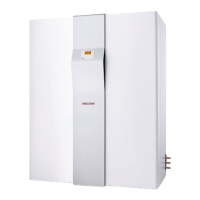4 | LWZ304-404 SOL www.stiebel-eltron.com
INSTALLATION
Safety
WARNING Electrocution
The connection to the power supply must be in the form
of a permanent connection. The appliance must be able
to be separated from the power supply by an isolator
that disconnects all poles with at least 3mm contact
separation. This requirement can be met by contactors,
isolators, fuses, etc.
!
Material losses
The specified voltage must match the mains voltage. Ob-
serve the type plate.
2.2 Instructions, standards and regulations
Note
Observe all applicable national and regional regulations
and instructions.
WARNING Burns
In connection with the fire prevention regulations con-
cerning the installation of ventilation systems, observe
all country-specific regulations and requirements. In
Germany, these are particularly the building regulation
guideline on fire prevention requirements of ventilation
systems in its applicable issue.
2.3 Operation of the appliance in buildings with
combustion equipment
If the building contains combustion equipment (tiled stoves, fire-
places, etc.), the responsible flue gas inspector must be consulted
in the planning phase. The flue gas inspector assesses whether all
statutory regulations are being observed. Here, a differentiation
is made between balanced and open flue combustion equipment.
For simultaneous operation of combustion equipment and a me-
chanical ventilation system, we recommend choosing approved
room sealed combustion equipment (in Germany with DIBt ap-
proval).
2.3.1 Room sealed combustion equipment
In conjunction with room sealed combustion equipment, no addi-
tional precautions are generally required. Assessment is carried
out by the flue gas inspector.
2.3.2 Open flue combustion equipment
!
WARNING – INJURY
If open flue combustion equipment is operated with the
mechanical ventilation system, tested safety equipment
must be installed. The combustion equipment must also
have a separate combustion air supply.
With open flue combustion equipment, a differentiation must be
made between alternate and simultaneous operation of the ven-
tilation system and combustion equipment.
Alternate operation
Operation on alternate sides means that, when the combustion
equipment is commissioned, the mechanical ventilation system is
switched off and cannot be started.
Note
Operation on alternate sides is not recommended be-
cause, in this case, central heating and DHW heating are
carried out by the electric emergency/booster heater.
Simultaneous operation
!
WARNING – INJURY
Ensure that no flue gas can enter the installation room
and that combustion equipment will always be supplied
with sufficient combustion air. Tested safety equipment
must be installed to monitor the chimney draught and
to switch off the ventilation unit in the event of a fault.
The equipment for differential pressure monitoring should fulfil
the following requirements:
- Monitoring of the differential pressure between the connec-
tion piece to the chimney and the room where the combus-
tion equipment is installed.
- Possibility of matching the shutdown value for the differential
pressure to the minimum draught requirement for the com-
bustion equipment.
- Floating contact to switch off the ventilation or heat pump
function.
- Optional connection of a temperature capturing device so
that differential pressure monitoring is only enabled when
the combustion equipment is in operation and so that un-
wanted shutdowns due to environmental influences can be
avoided.
Note
Differential pressure switches that use the pressure
differential between the outdoor air pressure and the
pressure in the room where the combustion equipment
is sited as a response criterion are not suitable.
Connect the safety equipment with a floating contact to ter-
minal X4-13/14 (contact "Oven / fireplace"). We recommend
installing a 5-core cable between the combustion equipment
and the ventilation unit.
Triggering the safety equipment may shut down the domestic ven-
tilation system and block the integral heat pump of the appliance.
You can determine how the appliance will behave following a
triggering of the safety equipment using the "OVEN / FIREPLACE"
parameter.
If you want the entire appliance to be switched off when the safety
equipment is triggered, you can integrate the safety of equipment
in the same way as an underfloor heating system thermostat (see
chapter "Specification/ Connection examples").
As the appliance in the installation room can produce negative
pressure, we recommend using a tightly sealing door between the
installation room and the living space for operation with combus-
tion equipment. If, due to its use, the installation room is connect-

